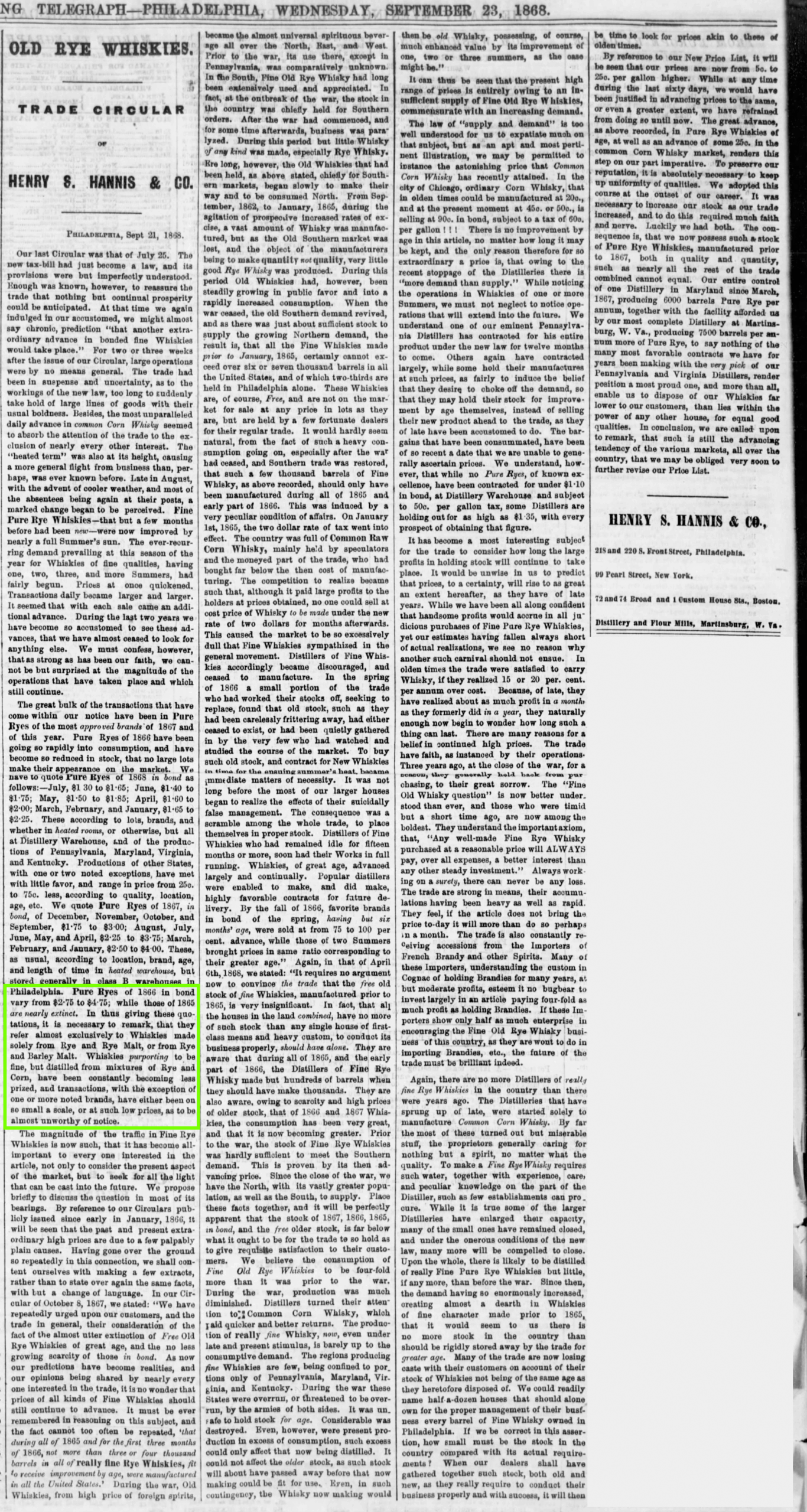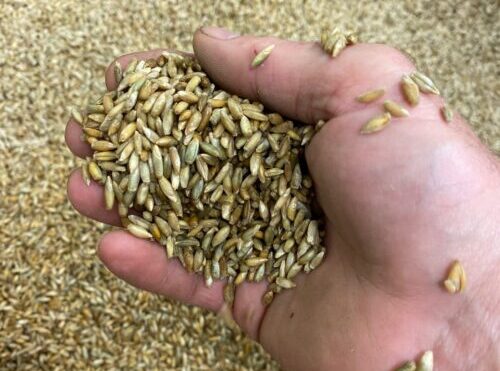In historic Pennsylvania rye whiskey mashbills, when a rye whiskey was described as being made of “rye and malt”, the assumption has always been that the “malt” in question always meant barley malt. Most modern whiskey historians have jumped to this conclusion because they were always looking at Pennsylvania rye whiskey through a modern lens. The inclusion of barley malt in Pennsylvania rye whiskey mashbills had, indeed, become normalized by the late 19th century, and several major PA distilleries whose brands survived Prohibition clearly advertised their use of barley malt (The Vandergrift, Gibson, and Overholt Distilleries were among the companies that described their use of barley in the late 1800s), but can we assume that barley had always been used? Historians love to point to Old Overholt Rye Whiskey which was clear about its 80/20 rye/barley malt mashbill, but Overholt’s Broad Ford Distillery cannot possibly speak for the entirety of Pennsylvania’s rye whiskey distillers- or even all of Western Pennsylvania’s producers! In fact, it’s quite likely that the Overholts were NOT using barley in the early 1800’s…the malt in question would, in all likelihood, have been RYE MALT. Malted rye was used before barley malt became an option for distillers in the late 19th century.

Barley was never grown in Pennsylvania in any significant quantities. Malted barley would not have been readily available in the late 18th and early 19th centuries unless it was being imported aboard ships. Distillers in places like Philadelphia likely had imported barley available, but the western half of the state would not have had the same access to it 200 years ago- at least not in any great quantities. It is much more likely that “Old Monongahela” was originally made from rye and rye malt in those early years, instead of rye and barley malt. One famous distiller in Pennsylvania that began making his rye whiskey in the 1830s and 40s described his rye whiskey as being made from 50% rye and 50% malt. That distiller was Thomas Moore, the old pioneer distiller of Old Possum Hollow. He most likely used rye malt in his rye mashes, and the high percentage of “malt” in relation to the percentage of rye speaks to that.
Barley became more available to distillers in Pennsylvania once railroads enabled access to barley being grown in other states, especially northern states like Michigan, Wisconsin, and Minnesota. It wasn’t until the railroads were established and Pennsylvania’s breweries began to bring barley to Pennsylvania in large quantities that barley became a real option for distillers. The ubiquity of large-scale breweries and their use of barley malt brought down its cost and made barley more readily available for spirits producers, even those with their own malting houses on site. Even after barley malt, with its high diastatic power, began to replace rye malt as a significant portion of rye whiskey mashbills in the late 1800s, rye malt often remained in the recipe. Rye malt never disappeared from rye whiskey recipes, and we can see this in grain recipes after Prohibition, as well.
Irving Hirsch, who consulted for a number of rye whiskey distilleries, was a chemical engineer living in Newark, New Jersey after Repeal. He covered the manufacture of whiskey as he knew it in his book, Manufacture of Whiskey, Brandy, and Cordials, written in 1937. He had a deep understanding of the manufacturing process of rye whiskey, which he makes clear throughout the book. The recipes for rye that were being used by the distilleries that Hirsch worked with during the 1930s were as follows:
1. 75% rye, 3% barley malt, 22% rye malt
2. 80% rye, 3% barley malt, 17% rye malt
3. 83% rye, 3% barley malt, 14% rye malt
4. 80% rye, 20% barley malt
5. 85% rye, 15% barley malt
6. 86% rye, 14% barley malt
7. 88% rye, 12% barley malt
It’s pretty clear from these recipes that rye malt remained an important part of rye whiskey production, even into the mid-20th century. Old Overholt is clearly represented, as well, with its 80/20, rye/barley malt mashbill.
Before Prohibition, the rye grain being used by Pennsylvania’s rye distilleries were not the varietals of rye grains being used today. The rye they were using would be now be referred to as “heritage rye” by modern distillers, and those rye varietals have largely disappeared from use. “Heritage rye” varietals contained a higher protein content and produced malt with more conversion power (diastatic power) to break down all those carbohydrates into simple sugars during the mashing process. These older styles of ryes also packed a lot more flavor. Unfortunately, that bigger punch of flavor also came with lower yields in alcohol production, which meant you needed more rye to manufacture the same amount of distillate that would come from modern ryes. While it may seem an easy decision to choose yield over flavor, Pennsylvania rye distillers were notorious for their stubborn refusal to abandon quality for quantity.
The text below, written in 1918, describes the use of a “malt mash” being used in the propagation of yeast. It explains that barley malt is most common, but that rye malt and wheat malt were also used. It also explains that distilleries with their own malting facility often employed the use of “green malt”. Green malt is not utilized today because a green malt contains too much moisture to be kept in storage- It could not be shipped without spoiling, so it would need to be used immediately, which could only be achieved when a malt house was beside a distillery. This practice of using freshly malted grain would have been a holdover from the previous century when distilleries malted their own grain on site. The use of green malt also speaks to a sweet mash technique, which was how Pennsylvania rye whiskey was made.

“These raw materials are treated, as in the brewing industry, with malt (mostly barley malt , sometimes also rye and wheat malt) in such a way that the diastase of the malt converts the starch into dextrin and sugar. But a distiller’s malt differs in its properties from à brewer’s malt. While the latter must impart its aroma and taste to the beer and only exert its diastatic power in a moderate degree, some of the starch remaining unchanged in the liquor, the former must be characterized by a maximum of diastatic power, to convert all the starch into fermentable sugar. Consequently the distiller prefers a malt from a small- kerneled barley, which has been killed (sic) at low temperatures. The diastatic power is weakened by high temperatures and hence some distillers, who operate a malting plant in connection with the distillery, used only green malt, or at most, air- dried malt. The German distillers universally use green malt. In contradistinction to the brewer, the distiller prefers a malt made from a barley rich in nitrogenous matter, as this latter furnishes material for the formation of diastase and for the nourishment of the yeast. The malt used by distillers is that known as ‘long malt’ (malted for 20 days) as distinguished from ‘short malt’ (malted for 7 days), used by the brewers. In making the long malt the grain is steeped until it has absorbed 40 to 45 per cent of water. It is then spread upon the malting floor for 20 days and kept at temperature not above 63 °. The development of mold or other bacteria is avoided by previously soaking the grain in diluted milk of lime. While the long malting causes a loss of starch, the gain of diastase far overbalances it. In mashing, the largest possible amount of starch must be converted into fermentable sugar (maltose) in order to obtain the highest yield of alcohol in the distillation. Under the most favorable conditions 96 per cent of the starch in the mash material can be converted into maltose (the remaining 4 per cent is changed into dextrin), while in ordinary practice only about 80 to 81 per cent maltose is obtained and the remainder is dextrin. After the maltose is decomposed into carbonic acid and alcohol , the dextrin is gradually converted by the diastase into maltose and then fermented . This can only be accomplished with vigorous yeast and proper treatment in the fermenting rooms. On account of this ‘after-effect’ the diastase must be carefully protected from destruction by avoiding high mashing-off temperatures and the formation of an excess of lactic acid and particularly butyric acid, produced by certain bacteria at a temperature of 104 ° to 122° F.”


